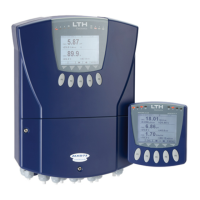Appendix
- 38 -
MXD70 Dissolved Oxygen
Setup and Operating Guide
Appendi
Appendix A - DO Measurement
Sensor Interface
The output signal from a Dissolved Oxygen sensor is in the form of a constant DC current which is
proportional to the partial pressure of the liquid being measured. In a 100% saturated solution at
room temperature and pressure, the output from a Galvanic sensor will be of the order of hundreds of
micro-amps (10
-6
Amps), whereas the output from a Polargraphic sensor will be of the order of
hundreds of nano-amps (10
-9
Amps).
In addition, Polargraphic sensors require a bias voltage to be applied between the cathode and anode
of the DO cell to excite an output.
The equation for converting current input to % saturation is as follows:
% Saturation = (I/I
o
) x P
c
x M x 100
Where: I = Measured Input Current
I
o
= 100% Saturation Current
P
c
= Pressure Correction Term
M = Membrane Correction Term
The pressure correction term compensates for the effect that pressure has on the solubility of oxygen
in water. This is almost directly proportional, i.e. a 10% variation in pressure will lead to a 10% variation
in the solubility and therefore saturation of the liquid.
The pressure correction term is defined as follows:
Po - P
vapor(To)
Pc = -------------------
P - P
vapor(T)
Where: Po = Pressure at 100% Calibration
P
vapor(T)
= Saturation Vapour Pressure at T
P = Pressure
T = Temperature
To = Temperature at 100% Calibration

